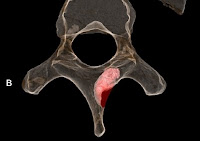Homo
naledi, a new species of Hominin
was described in 2013 from a series of complete skeletons found in
the Dinaledi (Rising Star) Chamber at the Maropeng Cradle of Humankind World Heritage Site. The presence of a large number of articulated
skeletons in a deep subsurface chamber was considered indicative of
organized burial practices by the species, which was surprising as
anatomically Homo naledi was
considered close to the earliest members of the genus Homo
or even later members of the genus Australopithicus,
species thought unlikely to have had advanced burial customs. Earlier
this year (2016) Francis Thackeray of the Evolutionary Studies Institute at the University of the Witwatersrand published a paper in the South African Journal of Science in which he
contended that a mottled pattern of manganese dioxide seen on the
surface of the bones could be the product of the action of
photosynthetic Lichens, and therefore possibly indicate that the cave
had been exposed at to the surface at the time when the bones were
laid down.
In
a second paper published in the South African Journal of Science on 28
September 2016, Patrick Randolph-Quinney of the School of Forensicand Applied Sciences at the University of Central Lancashire, and the
Evolutionary Studies Institute and School of Anatomical Sciences at
the University of the Witwatersrand, Lucinda Backwell and Lee Berger,
also of the Evolutionary Studies Institute at the University of the
Witwatersrand, John Hawks again of the Evolutionary Studies Institute
at the University of the Witwatersrand and of the Department of Anthropology at the University of Wisconsin-Madison, Paul Dirks and
Eric Roberts, also of the Evolutionary Studies Institute at the
University of the Witwatersrand and of the Department of Geoscience
at James Cook University, Godwin Nhauro once again of the
Evolutionary Studies Institute at the University of the Witwatersrand
and Jan Kramers of the Department of Geology at the University of Johannesburg, refute Thakeray's Lichen theory, and instead put
forward an alternative explanation for the mottling on the bones of
Homo naledi.
Patterns
of mineral staining affecting tibia U.W. 101-996. Note the
distribution of manganese (black) and iron (yellow-red) oxides around
the circumference of the shaft. Randolph-Quinney et al.
(2016).
Randolph-Quinney
et al. do not dispute
that Lichens grow in the vicinity of the Maropeng location, nor that
they absorb manganese from the rocks, nor that they redeposit excess
manganese on the rock surface, forming a mottled black pattern.
However they do observe that they are not the only organisms to act
in this way, noting that chemotrophic Bacteria are well known to
secrete both manganese and iron oxides in this way, often resulting
in a mottled pattern in old bones, and indeed in the case of older
specimens, turning the fossils completely black. Notably, such
Bactria do not require light in order to carry out this process
(unlike photosynthetic Lichens). This has two main implications;
firstly the chamber does not have to have been exposed to light, as
Bacteria will quite happily grow in the dark, and secondly the
mottling should have a random distribution upon the bones, as to a
pattern induced by a photosynthetic Lichen, which would by
concentrated on the upper, exposed surface, a distribution which is
indeed seen on the bones of Homo naledi.
Randolph-Quinney
et al. also make a
further observation, that such Bacteria induced manganese oxide
mottling will be concentrated along and soil surface the bones were
embedded in creating a 'tifde mark', as Bacteria are better able to
absorb minerals from the environment along such boundaries. Such
'tide marks' can be seen on the bones of Homo naledi.
Specimen
U.W. 101–419 Cranium A(1) displaying tide lines of mineral staining
which extends across different vault fragments. Tide lines mark a
contact boundary between the bone surface and surrounding sediment,
and indicate the resting orientation of the bone during precipitation
of the stains. Randolph-Quinney et al.
(2016).
See also...
 An osteogenic tumour in a 1.98-million-year-old Australopithicine from Malapa Cave, South Africa. Neoplasmic
tumors are areas of localized tissue growth where cellular
proliferation occurs without the oversight of the bodies growth
control...
An osteogenic tumour in a 1.98-million-year-old Australopithicine from Malapa Cave, South Africa. Neoplasmic
tumors are areas of localized tissue growth where cellular
proliferation occurs without the oversight of the bodies growth
control... Evidence of Lichen growth on the bones of Homo naledi. In 2013 scientists in South Africa described the discovery of a
remarkable new Hominin species in the Dinaledi Cave System in Gauteng
State, South Africa (part of the Maropeng Cradle of Humankind...
Evidence of Lichen growth on the bones of Homo naledi. In 2013 scientists in South Africa described the discovery of a
remarkable new Hominin species in the Dinaledi Cave System in Gauteng
State, South Africa (part of the Maropeng Cradle of Humankind... Malignant Osteosarcoma in a 1.7 million-year-old Hominin Metatarsal from Swartkrans Cave, South Africa. Malignant
Cancers are the biggest singe killer of...
Malignant Osteosarcoma in a 1.7 million-year-old Hominin Metatarsal from Swartkrans Cave, South Africa. Malignant
Cancers are the biggest singe killer of...
Follow Sciency Thoughts on Facebook.


